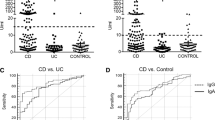Abstract
Background
Intestinal Behçet’s disease (BD) is a chronic inflammatory bowel disease, as are Crohn’s disease (CD) and ulcerative colitis (UC). But unlike CD and UC, serologic markers for intestinal BD are not well known. Recently, anti-α-enolase antibody (AAEA) has been detected in sera from BD patients.
Aims
The aim of this study was to evaluate the prevalence of AAEA in intestinal BD and its clinical correlations.
Methods
The study sample included 80 patients with intestinal BD and 23 healthy controls. IgM AAEA was detected by ELISA. The positivity of IgM AAEA was defined as an optical density greater than three standard deviations above the mean of the control sera. Other parameters, such as demographic information, subtype of BD, colonoscopic findings, disease severity and treatment modality, were analyzed retrospectively.
Results
The prevalence of IgM AAEA was 67.5% in intestinal BD and 0% in the control group. The positivity rate of IgM AAEA was higher in complete or incomplete BD than in suspected BD (77.5% vs. 51.6%, P = 0.016). The mean HBI score was higher in antibody positive patients than in antibody negative patients (5.60 vs. 4.61, P = 0.003). The cumulative probability of steroid use for aggravation of intestinal and extra-intestinal symptoms was higher in antibody positive patients than in antibody negative patients (P = 0.012). The number of patients with systemic involvement was higher in the AAEA positive group than in the negative group.
Conclusions
Monitoring IgM AAEA may be helpful for diagnosis of intestinal BD and could be used to predict clinical course and disease severity.



Similar content being viewed by others
References
Kaklamani VG, Vaiopoulos G, Kaklamanis PG. Behçet’s disease. Semin Arthritis Rheum. 1998;27:197–217.
Sakane T, Takeno M, Suzuki N, Inaba G. Behçet’s disease. N Engl J Med. 1999;341:1284–1291.
Yurdakul S, Hamuryudan V, Yazici H. Behçet’s disease. Curr Opin Rheumatol. 2004;16:38–42.
Saxon A, Shanahan F, Landers C, Ganz T, Targan S. A distinct subset of antineutrophil cytoplasmic antibodies is associated with inflammatory bowel disease. J Allergy Clin Immunol. 1990;86:202–210.
Ruemmele FM, Targan SR, Levy G, Dubinsky M, Braun J, Seidman EG. Diagnostic accuracy of serological assays in pediatric inflammatory bowel disease. Gastroenterology. 1998;115:822–829.
Peeters M, Joossens S, Vermeire S, Vlietinck R, Bossuyt X, Rutgeerts P. Diagnostic value of anti-Saccharomyces cerevisiae and antineutrophil cytoplasmic autoantibodies in inflammatory bowel disease. Am J Gastroenterol. 2001;96:730–734.
Quinton JF, Sendid B, Reumaux D, et al. Anti-Saccharomyces cerevisiae mannan antibodies combined with antineutrophil cytoplasmic autoantibodies in inflammatory bowel disease: prevalence and diagnostic role. Gut. 1998;42:788–791.
Sendid B, Colombel JF, Jacquinot PM, et al. Specific antibody response to oligomannosidic epitopes in Crohn’s disease. Clin Diagn Lab Immunol. 1996;3:219–226.
Adler Y, Salozhin K, Tongueze M, Shoenfeld Y, Youinou P. Anti-endothelial cell antibodies: a need for standardization. Lupus. 1994;3:77–84.
Meroni PL, Khamashta MA, Youinou P, Shoenfeld Y. Mosaic of anti-endothelial antibodies. Review of the first international workshop on anti-endothelial antibodies, clinical and pathological significance. Lupus. 1995;4:95–99.
Aydintug AO, Tokgoz G, D’Cruz DP, et al. Antibodies to endothelial cells in patients with Behçet’s disease. Clin Immunol Immunopathol. 1993;67:157–162.
Lee KH, Bang D, Choi ES, Chun WH, Lee ES, Lee S. Presence of circulating antibodies to a disease specific antigen on cultured human dermal microvascular endothelial cells in patients with Behçet’s disease. Arch Dermatol Res. 1999;291:374–381.
Lee KH, Chung HS, Kim HS, et al. Human alpha-enolase from endothelial cells as a target antigen of anti-endothelial cell antibody in Behçet’s disease. Arthritis Rheum. 2003;48:2025–2035.
Mizushima Y, Inaba G, Mimura Y. Diagnostic criteria for Behçet’s disease in 1987, and guideline for treating Behçet’s disease. Saishin Igaku. 1988;43:382–391. (in Japanese).
International Study Group for Behçet's Disease. Criteria for diagnosis of Behçet’s disease. Lancet. 1990;335:1078–1080.
Lee CR, Kim WH, Cho YS, et al. Colonoscopic findings in intestinal Behçet’s disease. Inflamm Bowel Dis. 2001;7:243–249.
Chung SY, Ha HK, Kim JH, et al. Radiologic findings of Behçet’s syndrome involving the gastrointestinal tract. Radiographics. 2001;21:911–924.
Pratesi F, Moscato S, Sabbatini A, Chimenti D, Bombardieri S, Migliorini P. Autoantibodies specific for alpha-enolase in systemic autoimmune disorders. J Rheumatol. 2000;27:109–115.
Pancholi V, Fischetti VA. Alpha-enolase, a novel strong plasmin(ogen) binding protein on the surface of pathogenic streptococci. J Biol Chem. 1998;273:14503–14515.
Pancholi V. Multifunctional alpha-enolase: its role in diseases. Cell Mol Life Sci. 2001;58:902–920.
Fontan PA, Pancholi V, Nociari MM, Fischetti VA. Antibodies to streptococcal surface enolase react with human alpha-enolase: implications in poststreptococcal sequelae. J Infect Dis. 2000;182:1712–1721.
Iida H, Yahara I. Yeast heat-shock protein of Mr 48,000 is an isoprotein of enolase. Nature. 1985;315:688–690.
Gitlits VM, Toh BH, Sentry JW. Disease association, origin, and clinical relevance of autoantibodies to the glycolytic enzyme enolase. J Investig Med. 2001;49:138–145.
Saulot V, Vittecoq O, Charlionet R, et al. Presence of autoantibodies to the glycolytic enzyme alpha-enolase in sera from patients with early rheumatoid arthritis. Arthritis Rheum. 2002;46:1196–1201.
Roozendaal C, Zhao MH, Horst G, et al. Catalase and alpha-enolase: two novel granulocyte autoantigens in inflammatory bowel disease (IBD). Clin Exp Immunol. 1998;112:10–16.
Lee S. Diagnostic criteria of Behçet’s disease: problems and suggestions. Yonsei Med J. 1997;38:365–369.
Acknowledgments
This study was supported by a research grant from Ferring Korea.
Author information
Authors and Affiliations
Corresponding author
Rights and permissions
About this article
Cite this article
Shin, S.J., Kim, B.C., Kim, T.I. et al. Anti-Alpha-Enolase Antibody as a Serologic Marker and Its Correlation with Disease Severity in Intestinal Behçet’s Disease. Dig Dis Sci 56, 812–818 (2011). https://doi.org/10.1007/s10620-010-1326-y
Received:
Accepted:
Published:
Issue Date:
DOI: https://doi.org/10.1007/s10620-010-1326-y




